Once upon a time, I was a psychology major in pursuit of understanding how the human brain works. While I may have decided that I have enough of my own personal problems to handle, let alone other people’s, what I learned during those years very much correlates with the job I do today.
As an SEO and marketing professional, a lot of what I do still relies on psychology, just applied differently. Every keyword typed, every headline clicked, every page abandoned after two seconds is a tiny behavioral data point. The better we understand the quirks of human decision-making, the better we can optimize websites, craft content, and drive conversions.
Which brings us to SEO psychology: the not-so-secret sauce that turns algorithms into opportunities.
What Is SEO Psychology?
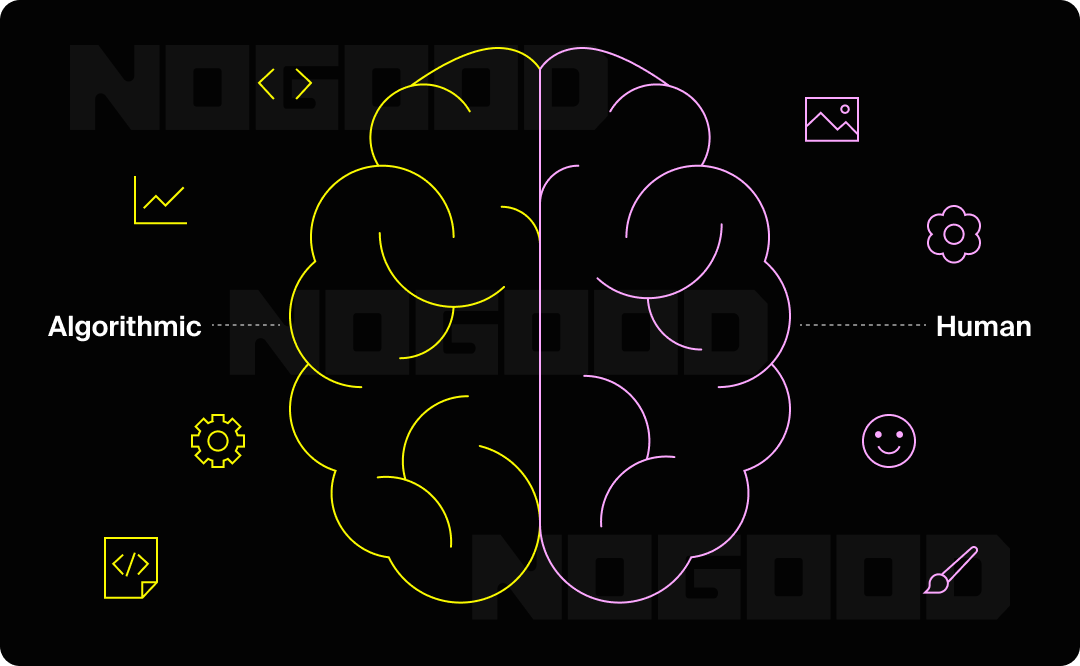
Humans are messy; algorithms are neat. The magic is in the overlap.
To give you a quick snapshot before I get into the nitty-gritty, SEO psychology is the art of decoding the human brain to win clicks, conversions, and rankings. Algorithms may set the stage, but human behavior steals the show.
Hopefully, you know what psychology is (or else I fear for the people in your life), but SEO psychology means studying how people actually behave when they’re searching, clicking, and deciding whether your website is worth their precious three seconds of attention. It’s not about tricking Google’s algorithm, but instead about understanding the workings of the human brain to build an SEO strategy around them (hint, hint: this also applies to CRO).
Consider this: Google ranks pages based on its complicated algorithm, but users (aka people) are the ones doing the clicking; and people don’t always click logically. They may click the headline that looks like the safe bet, or ones that capture curiosity or validate what they already think.
Users trust a .gov link because “official = smart”. They click the first result (or skip the sponsored results and click the first organic one) because scrolling feels like work, and if it’s #1, it’s gotta be good, right? And they’ll believe 5 stars from strangers on the internet more than a backed recommendation by someone who knows more than they do.
That, my friends, is psychology.
When you apply psychology principles to SEO, you stop treating keywords as just words and start treating them as clues into human intent. I mean, we literally categorize keywords based on whether they’re transactional, informational, commercial, or navigational, but that’s really just a starting point. It’s less about what people say they want, and more about what their behavior shows they’re actually looking for.
The Role of Psychology in SEO
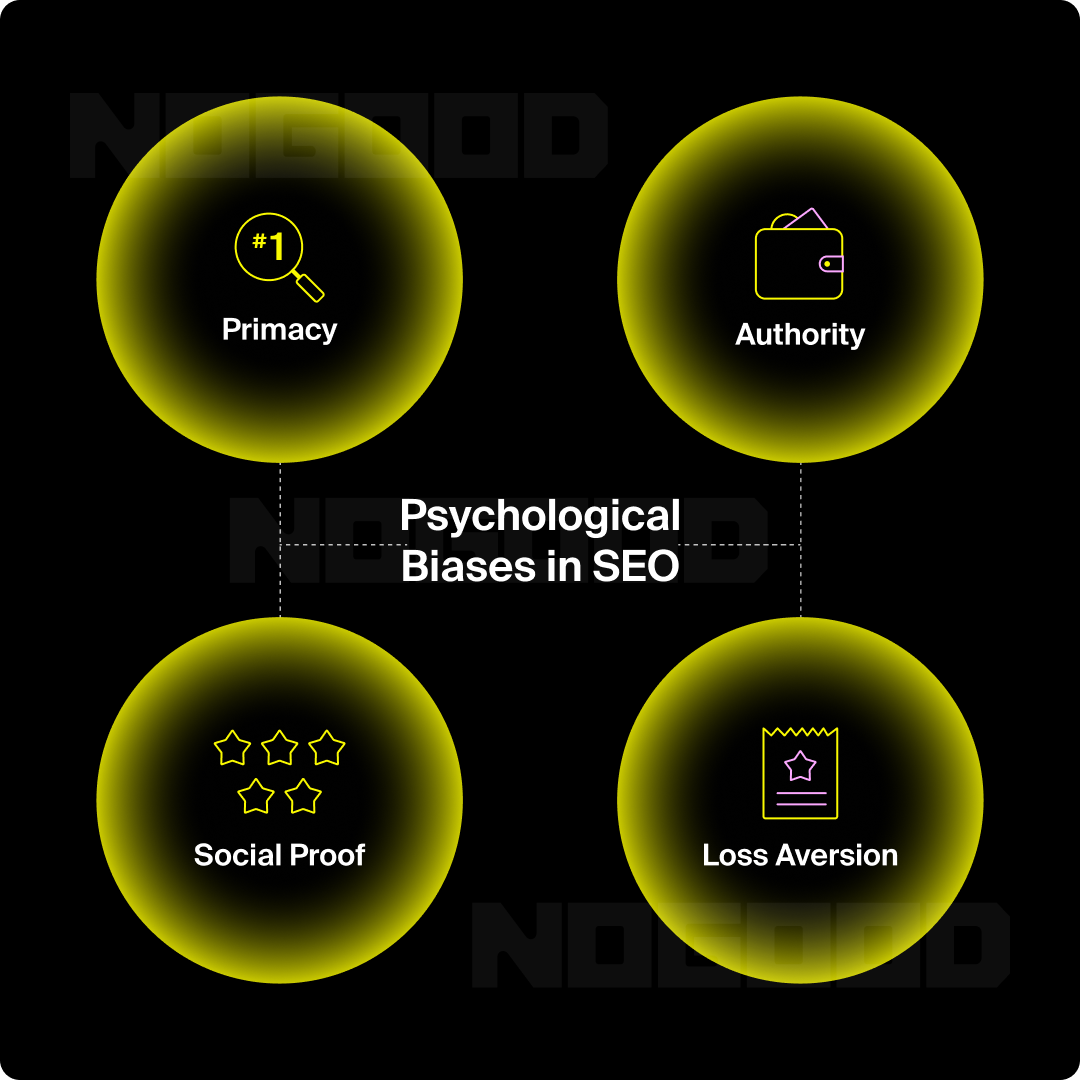
Your rankings aren’t shaped by robots alone; they’re shaped by our lizard brains too.
And we aren’t searching like rational adults. We search like impatient, biased, shortcut-loving creatures who just want the fastest answer that feels right. And Google knows it. That’s why psychology is baked into SEO, whether you realize it or not.
Let’s do a quick tour of the cognitive bias circus:
The Primacy Effect: Why #1 Steals the Show
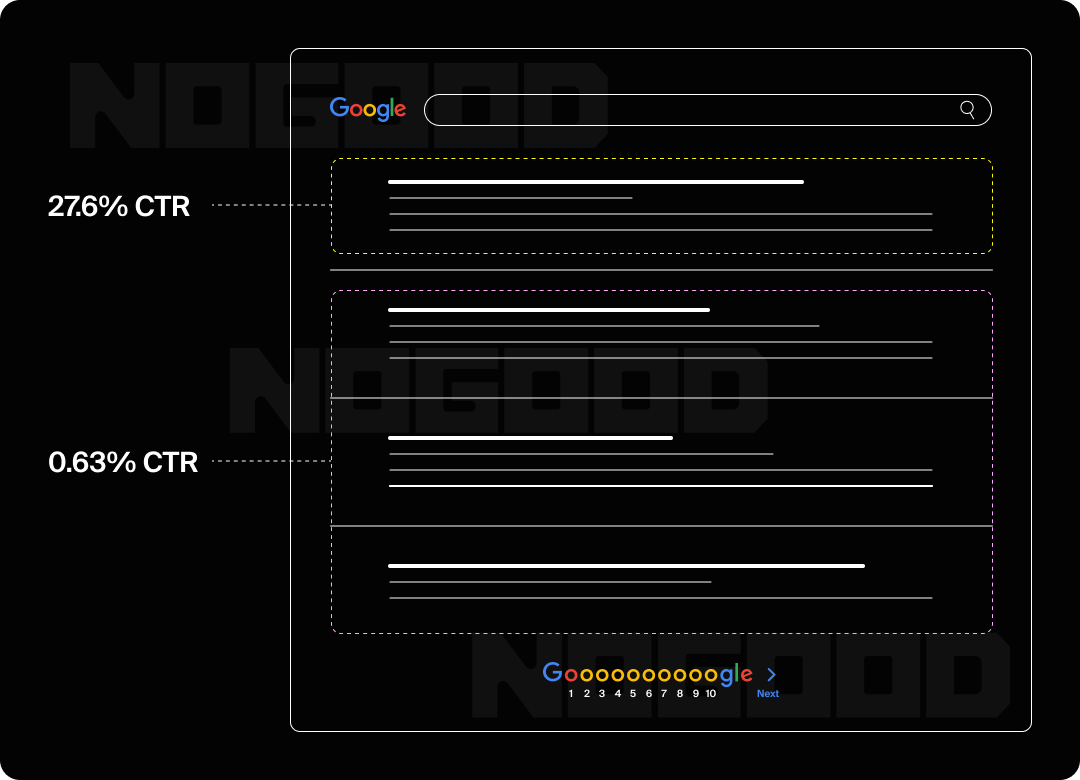
People are way more likely to click the first thing they see. In fact, the top organic result generates about 27% of all clicks. This is why being in Position #1 isn’t just bragging rights: it’s clicks, revenue, and sometimes world domination (muahaha). By the time someone scrolls to #3, you’re down to ~10% CTR, and after page one? Well, good luck, because only about 0.63% of searches even reach the second page.
SEO Takeaway: Fight for top placement on queries that matter most, but don’t ignore featured snippets, People Also Ask, or AI Overviews; they’re “position zero,” and our brains love that even more.
Authority Bias: People Always Trust the Suits
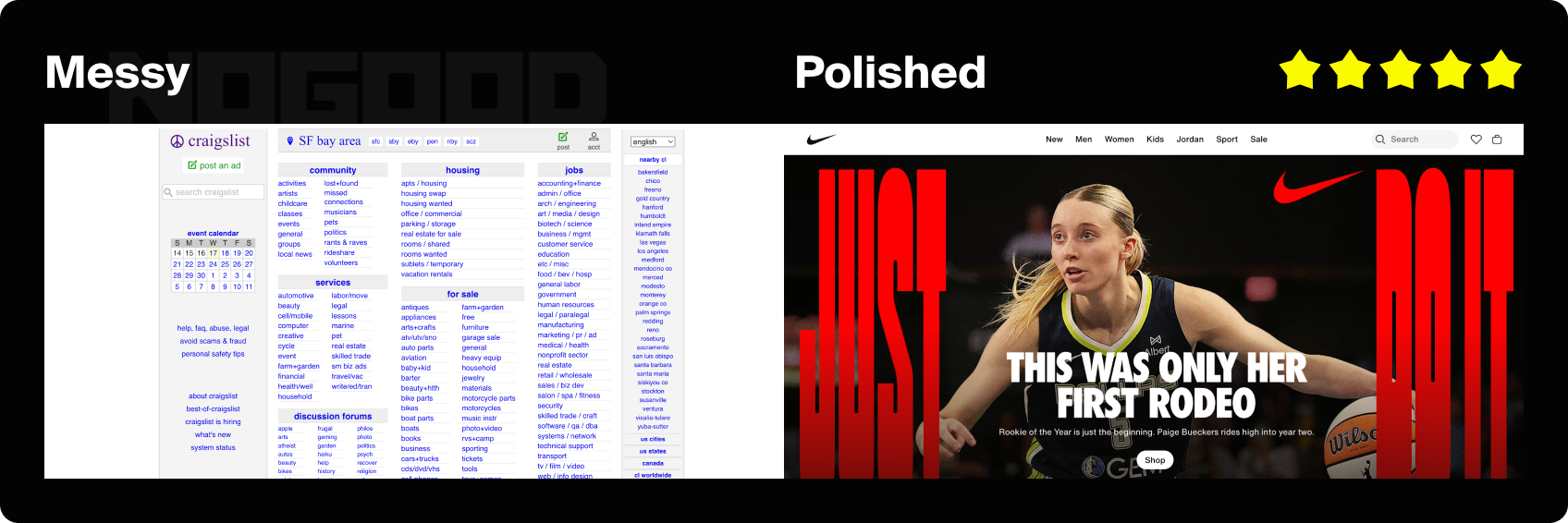
Users gravitate toward “official” sources. The Stanford Web Credibility Project found that about 46% of people judge website credibility based on visual design alone. Things like layout, typography, and general polishing are judged before users even read a word. Your marketing copy could be absolute gold, but if you don’t look legit, no one’s going to give you a second thought. Add a .gov domain or a big brand name? Suddenly, you’re in charge.
SEO Takeaway: If you can’t buy a .gov domain (you can’t), borrow credibility. Highlight credentials, show author bios, and get cited by authoritative sites to elevate your trust signal.
Social Proof: The Herd Always Wins
People are herd animals (sheep, if you will), and the herd is a little more skeptical than it used to be. In 2020, 79% of consumers trusted online reviews as much as personal recommendations, but by 2025, that number dropped to just 42%. Fake reviews, influencer fatigue, and general internet cynicism have chipped away at blind trust.
Still, 4 in 10 consumers relying on reviews as their digital second opinion is nothing to sneeze at. Reviews, testimonials, and those precious ⭐⭐⭐⭐⭐ snippets can tip the scale from a bounce to a click.

SEO Takeaway: Don’t bury your social proof. Use schema markup to surface reviews directly in search, highlight testimonials in your meta descriptions, and place trust signals where users see them fastest (above the fold). If the herd’s skeptical, meet them with transparency.
Loss Aversion: Why We’d Rather Not Lose Than Win
Humans are hardwired to hate losing even more than we love winning. Sounds crazy, right? Behavioral economists Daniel Kahneman and Amos Tversky proved this with Prospect Theory: the sting of losing $100 feels about twice as powerful as the joy of gaining $100.
That wiring shows up all over search behavior. Imagine two meta descriptions:
- “Save $50 a month with our plan.”
- “Stop losing $50 a month on overpriced plans.”
Same math, but with totally different brain responses. The second one really makes the “I might be wasting money” panic set in, so we’re more likely to buy in with a click.
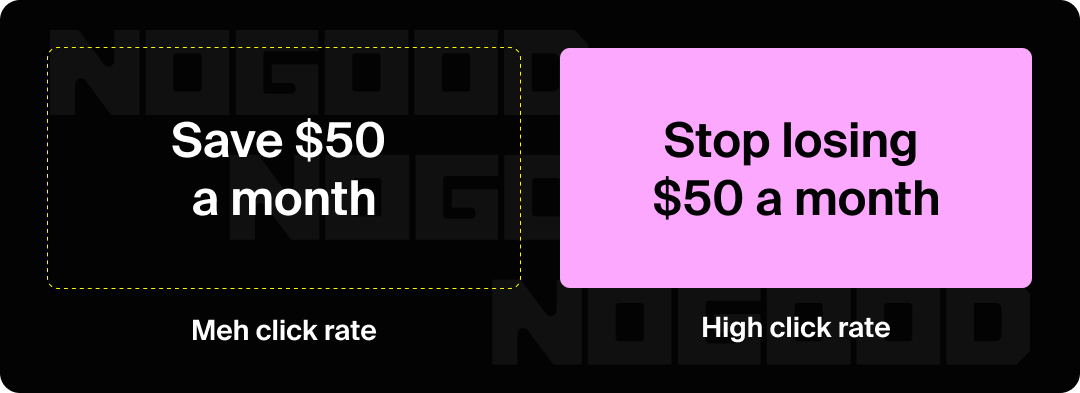
Loss aversion also explains why scarcity (“Only 2 left!”), urgency (“Sign up before midnight”), and exclusivity (“Don’t miss your invite”) are SEO and CRO tactics. They don’t just create FOMO; they trigger our brains’ natural loss-avoidance reflex.
SEO Takeaway: Audit your titles, meta descriptions, and CTAs for opportunity to flip the script. If you’re always talking about what users gain, test messaging that emphasizes what they’ll miss out on if they don’t click. Just don’t overdo it. Push too hard, and you slide from persuasive into scammy, which Google (and humans) are quick to punish.
SEO Is Human Behavior, Disguised as Data
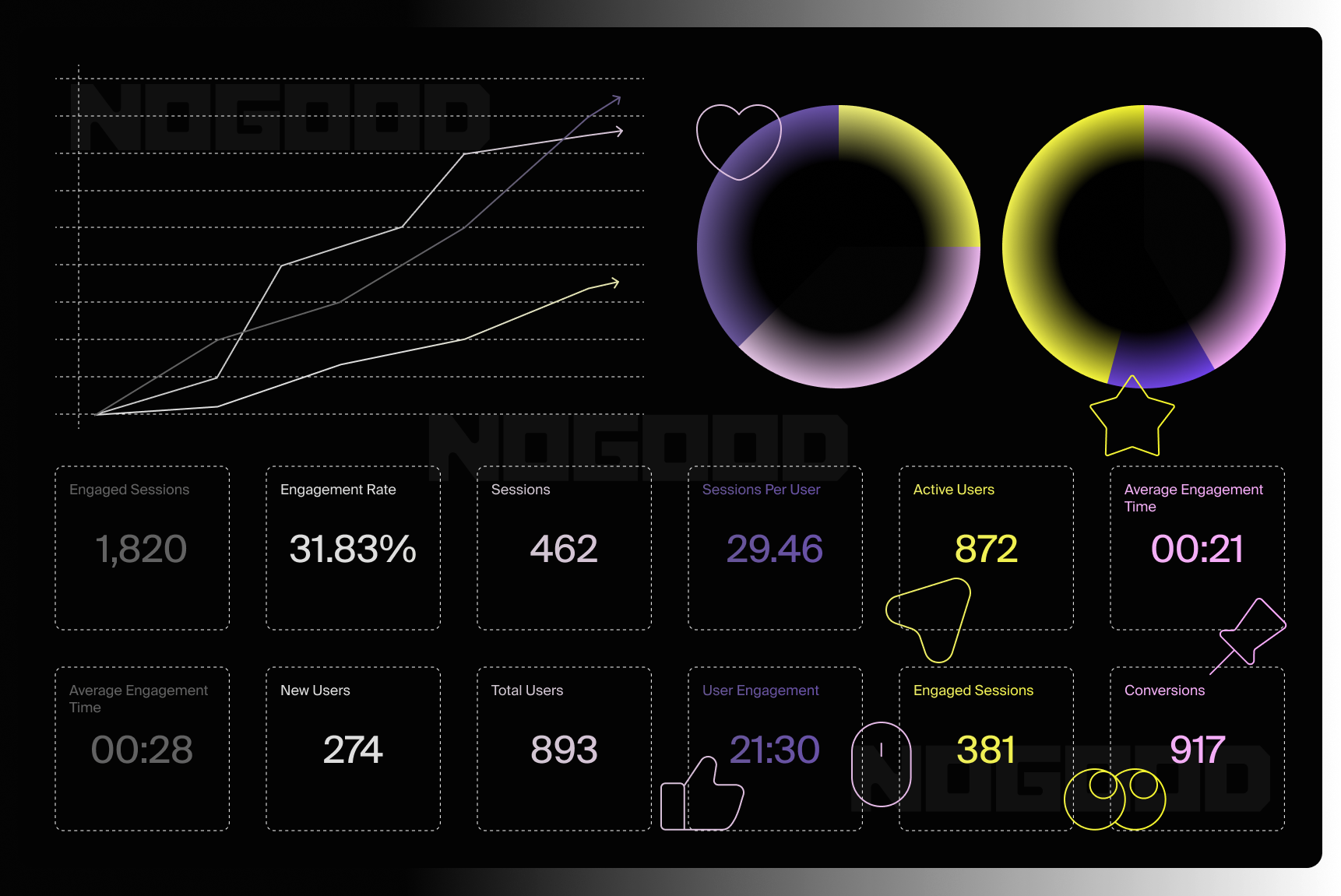
Google measures more than the face value of content; it measures how people respond to it. Every click, scroll, and bounce tells the algorithm what matters. When you factor in psychology, you realize that you’ve got more than search engines you have to worry about, but the messy, biased, shortcut-loving humans behind every query.
These quirks shape how humans behave, but Google’s job is to watch, measure, and adjust for every one of them. Which begs the question: how exactly do search engines make sense of our messy brains?
How Search Engines Work (Through a Human Lens)
Think of Google less like a robot overlord and more like a people-pleasing therapist with an endless filing cabinet, always trying to keep up with these messy brains of ours.
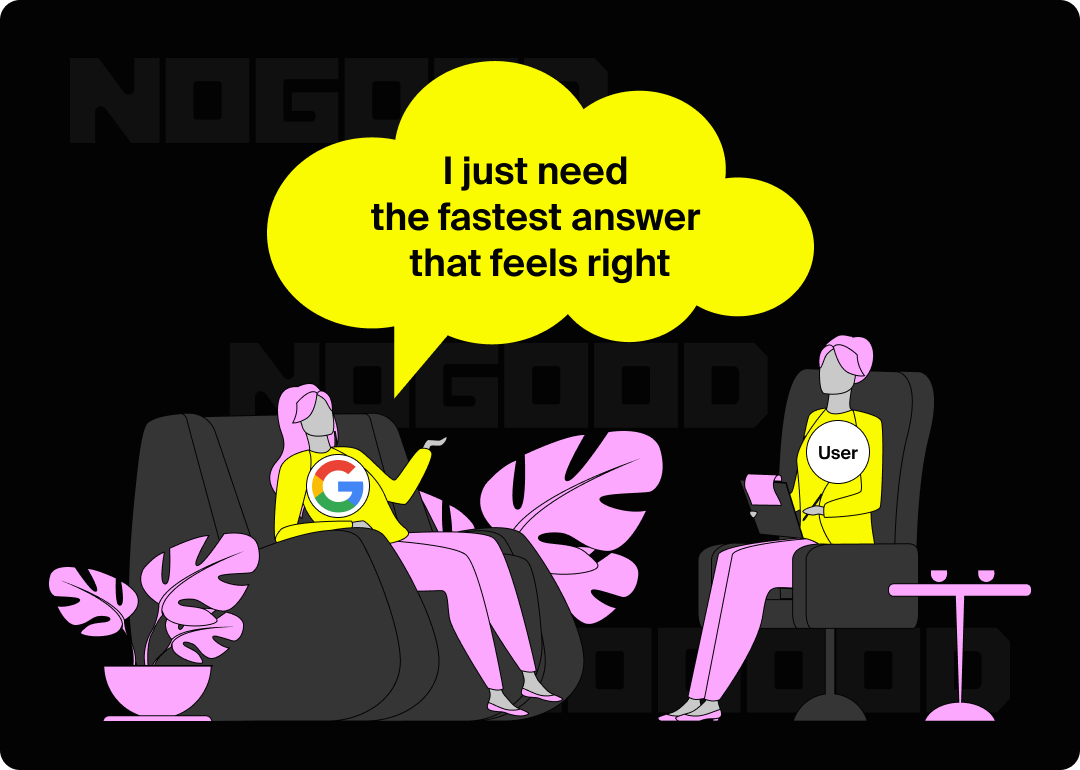
At a technical level, yes, search engines crawl, index, and rank trillions of pages. But if we look at it with a human lens, the algorithm is interpreting behavior and predicting intent. Google is doing more than matching words; it’s essentially trying to read your mind. Creepy? Yes. Does it work? Also, yes.
Here’s my (humanized) breakdown:
- Crawling = observation. Like a psychologist taking notes, Google is constantly gathering data: “Oh, you have a new page? Interesting. You linked it to this? Duly noted.”
- Indexing = organizing the thoughts. Every page gets filed away in Google’s mental Rolodex, ready to be pulled up when relevant.
- Ranking = interpretation. This is where it gets juicy: Google weighs signals like backlinks, authority, and increasingly behavioral cues. If users pogo-stick back to the SERP in two seconds flat, or bounce faster than you can say “keyword density,” that’s a red flag. If they linger and click deeper, that’s a trust signal.
And remember, this isn’t niche. Google holds over 90% of the global search market, which means, for better or worse, Google is the default interpreter of human curiosity. The algorithm is doing more than what pages are “relevant”, it’s constantly adapting to how billions of people search, click, and react every day.
That’s why updates like Panda, Medic (apt name), and Helpful Content exist: they’re basically therapy sessions for the algorithm, correcting for when humans chase clickbait, fall for quacks, or get lost in content farms.
So while search engines look like cold math from the outside, they’re actually behavioral mirrors. The algorithm follows the people, and the people follow their biases. And if Google is busy modeling our behavior, then the smartest SEO move is to do the same. That’s where psychology stops being theory and starts becoming a strategy.
How Psychology Helps Your SEO Strategy
Working these insights into your usual SEO playbook is where magic happens. Our psychological discussion about the quirky things humans do is now over, and it’s time to think about how we use it to shape the way we do keyword research, craft content, design pages, and write CTAs.
Every choice, from how you phrase your meta descriptions to where you place the reviews, is an opportunity to lean into how humans think and behave online.
1. Keyword Research: Think Like a Human, Not a Robot
People don’t search in spreadsheets; they search in feelings. Nobody types “information about sneakers designed with foot arch support technology”; they type “best running shoes for flat feet.” Long-tail queries are where human psychology leaks into the search bar.
Here’s how to use psychology to upgrade your keyword research:
- Mine Emotional Language: Look at how people phrase questions on Reddit, Quora, or even TikTok captions. Words like “worth it,” “safe,” “fast,” and “cheap” reveal underlying concerns (safety bias, loss aversion, urgency).
- People Also Ask: Those PAA boxes are basically Google saying, “Here’s what people are actually worried about.” Example: Search “credit card balance transfer” → PAA might surface “Does a balance transfer hurt my credit?” That’s fear of loss, a goldmine for content.
- Add Cognitive Bias to Keyword Clustering: Don’t just group by topic; group by intent+ bias.
- Trust-seeking: “best,” “top-rated,” “safe,” “reviews”
- Loss-averse: “avoid,” “don’t,” “stop wasting money”
- Urgency-driven: “now,” “fast,” “today”
- Spy on SERP Psychology: Look at what Google is rewarding. Are the top results framed positively (gain) or negatively (loss)? Do snippets use numbers (authority bias) or stories (social proof)?
- Go Beyond Search Volume: A keyword with 200 searches might drive more clicks than one with 2,000 if it taps into urgent, emotionally loaded intent.
2. Content Creation: Empathy Beats Algorithms
Google says it wants “helpful content.” Translation: content that feels human and actually solves problems. The psychology twist? We don’t read web pages like novels; we scan, hunt, and decide in seconds whether to stay or bail.
How to layer psychology onto content:
- Chunk It Like Candy → Use short paragraphs, bullets, and headers. Our brains love digestible info (Cognitive Load Theory). Hint: This is also good practice for AI search engines (hello, Answer Engine Optimization).
- Match Emotional Tone → If someone’s searching “how to fix a broken hard drive,” they want calm authority, not jokes. If they’re searching “best gaming headsets,” they’ll tolerate (and hopefully enjoy) a playful tone.
- Leverage the Curiosity Gap → Titles like “7 Mistakes You’re Probably Making…” tap into our itch to resolve uncertainty (information gap theory). Just don’t be click-baity about it.
3. UX & Design: Trust Is Visual Before It’s Verbal
Humans judge with their eyes before their brains catch up. Remember that Stanford study? Well, hear ye, hear ye, because 46% of users say design is the #1 factor in judging site credibility. That’s authority bias at work before they’ve read a single word.
How to put psychology into UX:
- Above-the-Fold Trust Cues → Add logos, testimonials, or star ratings right where people land.
- Consistency = Safety → Weird fonts, broken layouts, or janky mobile views = subconscious red flags.
- Visual Hierarchy Matters → Big bold CTA vs. tiny link buried in a paragraph? Guess which gets clicked.
- Speed is Trust → 53% of users bounce if a page takes longer than three seconds to load. Slow sites feel shady.
Consider running your website through a “First 5 seconds” test. Show it to someone for 5 seconds, close it, and ask what they remember. If they didn’t mention trust signals, a theory on what the site is about, or a clear next step, it might be worth a redesign.
4. Calls-to-Action: The Bias Playground
If SEO is about getting people in the door, CTAs are about getting them to do something once they’re inside. Psychology turns a bland “Learn More” into a click magnet.
How to blend psychology into CTAs:
- Loss vs. Gain Framing → “Stop losing leads” vs. “Get more leads.” (Test both; humans lean loss-averse.)
- Urgency Triggers → Add countdown timers or language like “Today only.” But keep it real, fake scarcity backfires.
- Reciprocity Principle → Offer something free upfront (“Free guide,” “Free audit”). People feel compelled to give back.
- Choice Architecture → Nudge with limited options. “Start Free Trial” vs. “Talk to Sales” feels less overwhelming than six different buttons.
Run A/B tests not just on placement but on framing bias. Tag CTAs in your analytics as “loss-framed” or “gain-framed” and see which consistently wins.
5. Social Proof Placement: Let the Herd Do the Heavy Lifting
Reviews and testimonials work because we’re hardwired to follow the crowd. Even though trust in reviews dropped to 42% in 2025, that’s still nearly half of your audience outsourcing decisions to strangers online. And when done right (meaning you’re not paying for reviews), I’m willing to bet that number climbs up.
And now, it’s not just humans recommending products — AI is, too. Whether it’s Google’s AI Overviews, ChatGPT, or Perplexity, these systems are trained on collective behavior and published content, which means they’re essentially amplifying social proof at scale.
How to put psychology into social proof
- Surface It Early → Reviews in your SERP snippet (schema markup) win clicks before people even see your site.
- Contextual Proof → Don’t just dump testimonials on a generic “Reviews” page. Place them right where objections might arise (e.g., near pricing).
- Numbers + Stories → “Trusted by 10,000 users” appeals to herd instincts, while a detailed testimonial taps into narrative bias.
- Diversity Matters → A wall of reviews from people who all look and sound alike can feel fake. Showcase different voices for credibility.
Run a scroll depth analysis on key pages. If reviews or testimonials appear below the 50% scroll mark, move them up.
6. Analytics & Iteration: Psychology Isn’t Static
What worked yesterday may flop tomorrow. Reviews were gospel in 2020; by 2025, skepticism rules. Analytics aren’t just numbers, but windows into shifting psychology.
How to put psychology into iteration:
- Watch Dwell Time → A high bounce rate might not mean bad content, it could mean unmet expectations from your title or meta.
- Heatmap Behavior → Rage clicks and ignored CTAs = design psychology mismatch.
- Segment by Intent → Check which queries drive pogo-sticking (quick back-to-SERP). Those keywords need better alignment with search intent.
- Experiment With Bias Framing → Test urgency vs. authority vs. social proof-driven copy across the same CTA.
In GA4 or your preferred analytics tool, set up event tracking on CTA clicks with labels like loss-framed or authority-driven. Over time, you’ll see which psychological lever performs best in your niche.
SEO psychology isn’t about guessing what people want; it’s about testing how they actually behave. Data tells you when a bias hits home, and iteration keeps you ahead of shifting human quirks.
SEO Is More Human Than Algorithm
Some think SEO is about tricking algorithms. In reality, SEO psychology is about decoding humans. Cognitive biases like primacy, authority, social proof, and loss aversion are academic theories that shape clicks, trust, and conversions every single day.
We may think of search engines as these invisible machines, but they’re really just human feedback loop, constantly adjusting to how we think, scroll, and decide. That means your SEO strategy shouldn’t just optimize for keywords but also the messy, hack-hunting humans behind them.
You don’t have to shout the loudest to win, you just need to get your audience: what they fear, what they trust, and what makes them click. Do that well, and SEO stops being an algorithm arms race and starts being a masterclass in human behavior.






